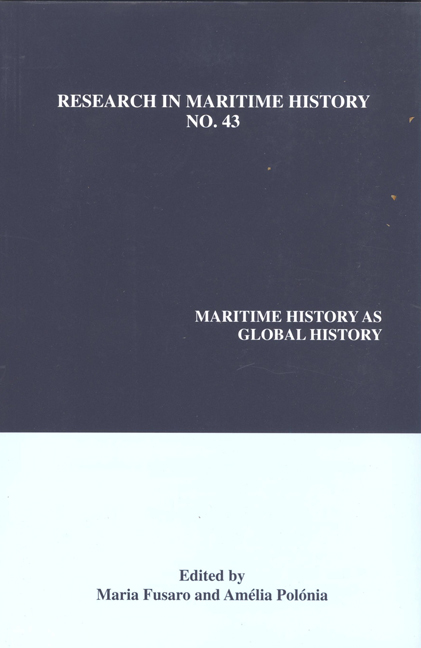Book contents
- Frontmatter
- Contents
- About the Editors
- Contributors' Notes
- “Maritime History: A Gateway to Global History?”
- “Behind the Atlantic Expansion: Flemish Trade Connections of Seville in 1620”
- “National and International Labour Markets for Sailors in European, Atlantic and Asian Waters, 1600-1850”
- “Maritime Expansion and (De)globalization? An Examination of the Land and Sea Trade in Seventeenth-Century Mughal India”
- “From Hold to Foredeck: Slave Professions in the Maritime World of the East India Company, c. 1660-1720”
- “Small Town Merchants, Global Ventures: The Maritime Trade of the New Julfan Armenians in the Seventeenth and Eighteenth Centuries”
- “Lighting up the World? Empires and Islanders in the Pacific Whaling Industry, 1790-1860”
- “Technological Advances in the Maritime Sector: Some Implications for Trade, Modernization and the Process of Globalization in the Nineteenth Century”
- “Lost in Calculation? Norwegian Merchant Shipping in Asia, 1870-1914”
- “Why Are the Major Oil Companies Selling Off their Fleets? The Case of Total”
- “Turning Maritime History into Global History: Some Conclusions from the Impact of Globalization in Early Modern Spain”
- “Maritime History as Global History? The Methodological Challenges and a Future Research Agenda”
“Lost in Calculation? Norwegian Merchant Shipping in Asia, 1870-1914”
- Frontmatter
- Contents
- About the Editors
- Contributors' Notes
- “Maritime History: A Gateway to Global History?”
- “Behind the Atlantic Expansion: Flemish Trade Connections of Seville in 1620”
- “National and International Labour Markets for Sailors in European, Atlantic and Asian Waters, 1600-1850”
- “Maritime Expansion and (De)globalization? An Examination of the Land and Sea Trade in Seventeenth-Century Mughal India”
- “From Hold to Foredeck: Slave Professions in the Maritime World of the East India Company, c. 1660-1720”
- “Small Town Merchants, Global Ventures: The Maritime Trade of the New Julfan Armenians in the Seventeenth and Eighteenth Centuries”
- “Lighting up the World? Empires and Islanders in the Pacific Whaling Industry, 1790-1860”
- “Technological Advances in the Maritime Sector: Some Implications for Trade, Modernization and the Process of Globalization in the Nineteenth Century”
- “Lost in Calculation? Norwegian Merchant Shipping in Asia, 1870-1914”
- “Why Are the Major Oil Companies Selling Off their Fleets? The Case of Total”
- “Turning Maritime History into Global History: Some Conclusions from the Impact of Globalization in Early Modern Spain”
- “Maritime History as Global History? The Methodological Challenges and a Future Research Agenda”
Summary
Introduction
Since the rise of global history in the late twentieth century, there have been an increasing number of studies of historical encounters between East and West, particularly those that occurred in the nineteenth century. In the fields of economic and business history, a considerable part of the response to global history has been directed towards the opening of Asian markets to foreign trade, while only marginal attention has been paid to the exchange of services within the same context. This essay addresses this issue by exploring the involvement of the Norwegian merchant fleet in Asian markets for seaborne transport between the opening of the Suez Canal and the outbreak of World War I. Our point of departure is a set of contemporary quantitative and qualitative sources that offer detailed information about the engagement of Norwegian vessels in the international economy. Even though some of the sources are Norwegian, their scope is global. During the second half of the nineteenth century, Norwegian merchant shipping was transformed from a regional, export-based orientation to a global enterprise which literally sailed the seven seas. This paper examines a neglected and largely forgotten chapter of this transformation. The story, however, goes beyond a mere national narrative. Maritime history offers a unique prism for studying the connections between humans, cultures and ideas. Here we offer some insights into how economic agents in geographically distant places not only established connections but also increased them within a relatively short period. In this respect, it is a tale of economic globalization and transnational economic history.
In order to conduct this study, we have established two purpose-built databases, both based on systematic collections of contemporary shipping statistics. The first comprises an extensive data set compiled by officials at Statistics Norway that offers key information on Norwegian vessels arriving in or departing from Asian ports (hereafter the NOS database). The second is based on data on Norwegian vessel movements in Asia at ten-year intervals, covering the years 1882, 1892, 1902 and 1912, as published in Lloyd's Weekly Shipping Index (hereafter the LWSI database). Our initial ambition was to crossreference the two data sets. Though the sources were of disparate origins and were collected for different purposes, we believed in principle that there should have been a high degree of congruence between the two. As we will explain later, however, we uncovered some rather substantial discrepancies.
- Type
- Chapter
- Information
- Maritime History as Global History , pp. 203 - 222Publisher: Liverpool University PressPrint publication year: 2010



